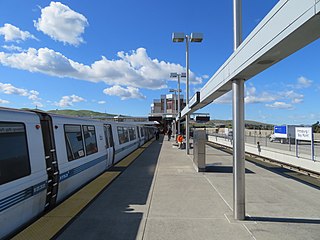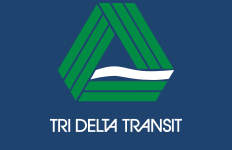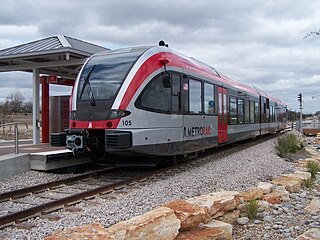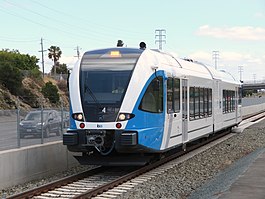
A diesel multiple unit or DMU is a multiple-unit train powered by on-board diesel engines. A DMU requires no separate locomotive, as the engines are incorporated into one or more of the carriages. Diesel-powered single-unit railcars are also generally classed as DMUs. Diesel-powered units may be further classified by their transmission type: diesel–mechanical DMMU, diesel–hydraulic DHMU, or diesel–electric DEMU.

Bay Area Rapid Transit (BART) is a rapid transit system serving the San Francisco Bay Area in California. BART serves 50 stations along six routes and 131 miles of track, including a 9-mile (14 km) spur line running to Antioch, which uses diesel multiple unit vehicles, and a 3-mile (4.8 km) automated guideway transit line serving Oakland International Airport. With an average of 164,500 weekday passengers as of the third quarter of 2023 and 41,286,400 annual passengers in 2022, BART is the seventh-busiest heavy rail rapid transit system in the United States.

AC Transit is an Oakland-based public transit agency serving the western portions of Alameda and Contra Costa counties in the East Bay of the San Francisco Bay Area. AC Transit also operates "Transbay" routes across San Francisco Bay to San Francisco and selected areas in San Mateo and Santa Clara counties. AC Transit is constituted as a special district under California law. It is governed by seven elected members. It is not a part of or under the control of Alameda or Contra Costa counties or any local jurisdictions.

The Yellow Line is a Bay Area Rapid Transit (BART) line in the San Francisco Bay Area that runs between Antioch and San Francisco International Airport (SFO). Some morning trains and all trains after 9 pm are extended from SFO to serve Millbrae station when the Red Line is not running. It serves 28 stations in Antioch, Pittsburg, Bay Point, Concord, Pleasant Hill, Walnut Creek, Lafayette, Orinda, Oakland, San Francisco, Daly City, Colma, South San Francisco, San Bruno, and Millbrae. It is the most-used BART line, and the only line with additional trains on weekdays.

Millbrae station is an intermodal transit station serving Bay Area Rapid Transit (BART) and Caltrain, located in Millbrae, California. The station is the terminal station for BART on the San Francisco Peninsula, served by two lines: The Red Line before 9 pm and the Yellow Line during the early morning and evening. It is served by all Caltrain services. The station is also served by SamTrans bus service, Commute.org and Caltrain shuttle buses, and other shuttles.

12th Street/Oakland City Center station is an underground Bay Area Rapid Transit (BART) station located under Broadway between 12th Street and 14th Street in Downtown Oakland, adjacent to the Oakland City Center. It is the second-busiest BART station in both Oakland and the East Bay, and the 6th busiest BART station overall, with a daily ridership of approximately 5,000 in September 2023.

19th Street Oakland station is an underground Bay Area Rapid Transit (BART) station located under Broadway between 17th Street and 20th Street in the Uptown District of Oakland, California. It is a timed transfer point between northbound trains to Richmond and to Antioch. It is the busiest BART station in both Oakland and the East Bay, and the 5th busiest BART station overall, with a daily ridership of approximately 4,700 in September 2023.

Richmond station is an Amtrak intercity rail and Bay Area Rapid Transit (BART) station located in downtown Richmond, California. Richmond is the north terminus of BART service on the Orange Line and Red Line; it is a stop for Amtrak's Capitol Corridor, San Joaquins, and California Zephyr routes. The accessible station has one island platform for the two BART tracks, with a second island platform serving two of the three tracks of the Union Pacific Railroad Martinez Subdivision for Amtrak trains. It is one of two transfer points between BART and Amtrak, along with Oakland Coliseum station.

Downtown Berkeley station is an underground Bay Area Rapid Transit (BART) station in the Downtown Berkeley section of Berkeley, California. It is served by the Orange Line and Red Line.

North Concord/Martinez station is a Bay Area Rapid Transit (BART) station located in the Sun Terrace neighborhood of Concord, California. The station serves the northern area of Concord and nearby Martinez. It is located near State Route 4. It is served by the Yellow Line.

Pittsburg/Bay Point station is a Bay Area Rapid Transit station in Pittsburg, California, United States, adjacent to the community of Bay Point. It serves northern and eastern Contra Costa County, as well as the Sacramento–San Joaquin River Delta. Passengers transfer between the light and heavy rail portions of the Yellow Line here, at a dedicated transfer platform east of the main station.

Tri Delta Transit, formally the Eastern Contra Costa Transit Authority, is a joint powers agency of the governments of Pittsburg, Antioch, Oakley, Brentwood, and Contra Costa County that provides bus service for the eastern area of Contra Costa County, California, United States. Tri Delta Transit local buses connect to the BART rapid transit system at Pittsburg/Bay Point and Concord. Tri Delta Transit buses also connect with County Connection bus service, WestCAT bus service, Delta Breeze bus service and Amtrak at shared bus stops. In 2022, the system had a ridership of 1,045,300, or about 4,800 per weekday as of the third quarter of 2023.

The Stadler GTW is an articulated railcar for local transport made by Stadler Rail of Switzerland. GTW stands for Gelenktriebwagen.
Throughout the history of Bay Area Rapid Transit, there have been plans to extend service to other areas.
Bay Area Rapid Transit, widely known by the acronym BART, is the main rail transportation system for the San Francisco Bay Area. It was envisioned as early as 1946 but the construction of the original system began in the 1960s.

Pittsburg Center station is a Bay Area Rapid Transit station on the Yellow Line. It is located at the Railroad Avenue overpass of Highway 4 in Pittsburg, California and serves the downtown area of about one mile (1.6 km) away via connecting buses provided by Tri Delta Transit. There is no reserved parking available at this station.

Antioch station is a Bay Area Rapid Transit (BART) station on the Yellow Line. It is located in the median of Highway 4 at Hillcrest Avenue in Antioch, California. Antioch station is the eastern terminus of the BART to Antioch (eBART) section of the line.
The rolling stock of the Bay Area Rapid Transit (BART) system consists of 782 self-propelled electric multiple units, built in four separate orders.

The SFO–Millbrae line was a Bay Area Rapid Transit (BART) shuttle line in the San Francisco Bay Area that ran between Millbrae station and San Francisco International Airport station (SFO). The line was colored purple on maps, and BART sometimes called it the Purple Line. The line was a shuttle service with no intermediate stops; it shared tracks with two of the five other mainline BART services. The service operated from June 2003 to February 2004 and from February 2019 to August 2021.



















